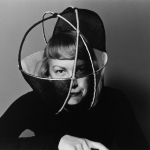Background
Andrade was born in Portsmouth, Virginia, United States, on January 25, 1917.

Philadelphia, Pennsylvania 19104, United States
University of Pennsylvania.
118-128 N Broad St, Philadelphia, Pennsylvania 19102, United States
Pennsylvania Academy of Fine Arts.
320 S Broad St, Philadelphia, Pennsylvania 19102, United States
University of the Arts.
1801 N Broad St, Philadelphia, Pennsylvania 19122, United States
Temple University.
Edna Andrade with her artwork.







Andrade was born in Portsmouth, Virginia, United States, on January 25, 1917.
Edna Andrade's talent for drawing was noticed when she was a child, and from the age of eight Andrade was encouraged to practice drawing and painting. She studied at the Barnes Foundation in Merion, Pennsylvania from 1935 to 1936. She won Cresson Scholarships to travel to Europe in 1936 and 1937. The artistic experimentation occurring in Europe greatly influenced her approach to design, color, and abstraction. In 1937 she received a Bachelor of Fine Arts degree from the University of Pennsylvania. In 1938 she finished her Post Graduate studies at the Pennsylvania Academy of Fine Arts.
At the beginning of her professional life, Andrade served as a teacher of art at an elementary school in Norfolk, Virginia. Subsequently, she taught at Tulane University in New Orleans. In 1946 Edna Andrade with her husband moved to Philadelphia, where she remained for the rest of her life. Initially, she painted on a freelance basis, but didn’t take charge of her career until her divorce.
Edna Andrade’s early work consisted of watercolor collages and ink drawing of abstracted landscapes (an outpouring of art). During the Second World War, she worked on propaganda materials for what is now the Central Intelligence Agency (CIA). Some of her public artworks were commissioned by the Free Library of Philadelphia and the Salvation Army. At the beginning of the 1950s, Edna Andrade created highly abstract, geometric paintings that used a limited color palette and also a variety of shapes.
Andrade became a participant in the "op art" movement of the 1960s. Her work prefigured that of many artists who experimented with color and optical effects across complex geometric fields, including Gabriele Evertz, Bridget Riley, and Robert Swain. She made smart use of complicated imagery, as, for instance, in a series of works from the 1980s, in which Edna Andrade appropriated the mathematically determined patterns used to decorate Islamic architecture. She once noted that she was struck by "how little it takes to upset the eye." With her chromatic spectrums and intricate geometric patterns, she challenged viewers to engage new and different visual logics. In her later work, Edna Andrade returned to painting abstracted landscapes and practices the more fundamental art techniques she learned while studying at the Pennsylvania Academy of Fine Arts. Andrade was particularly influenced by architectural design, philosophy, mathematics, and design. Also, she was strongly inspired by such things such as astrophysics and Freudian psychology.
In addition to her career as a painter, she also taught at a number of universities. From 1957 to 1972 she was a professor of art at the Philadelphia University of Art and from 1972 professor of art at Temple University.

In 1991 Edna Andrade received Philadelphia’s Mayor’s Arts and Culture Award for Visual Arts as well as the Distinguished Teaching Award from the College Art Association in 1996. In the year of 1997 the Leeway Foundation established the Edna Andrade Emerging Artist Award to encourage and assist female artists in their artistic careers. The Edna Andrade Summer Scholarship was established at the University of Pennsylvania in 2013, it provides travel for student researchers.
By now there have been two major retrospectives of the artst's artworks, one in her lifetime and one after her death. The first exhibition was held in 1993 at the Pennsylvania Academy of Fine Arts and the second in 2003 at the Institute of Contemporary Art at the University of Pennsylvania.
Edna Andrade's work is in numerous collections including the Philadelphia Museum of Art, The Museum of Contemporary Art Buenos Aires, the Pennsylvania Academy of the Fine Arts, the Houston Museum of Fine Arts, the Dallas Museum of Art, Virginia Museum of Fine Arts and Baltimore Art Museum, the Utah Museum of Fine Arts, and the Delaware Art Museum. Her papers are held at the Archives of American Art.
Earth Day
Finale
Orange Cisoide
Hot Clouds II
Color Motion 4-64
Radiant Ellipse 3-65
Color Motion 2-64
Torsion
Cross
Ahmet Hello
Turbo 1-65
Radiant Ellipse 2-65
Short Ride
Atom Cloud
Black Dragon
Black Diamond
Twilight Wave
Flying Cross
Moongate 'A"
Mirage (Marian Locks Gallery & Readers' Digest Association Labels)
Philosopher's Garden
Fortress
Sunset Western Way
Blue Cross With Red (Cruz azul con rojo)
Untitled
Red Disc
Untitled (Orange Blocks)
Cross
Four Hot Planets
XI 64
Garden
ROTATION NO. 1
Summer Game
Temple
Seawall
In 1941 Edna Andrade married architect Preston Andrade. The couple broke up and divorced in 1960.
